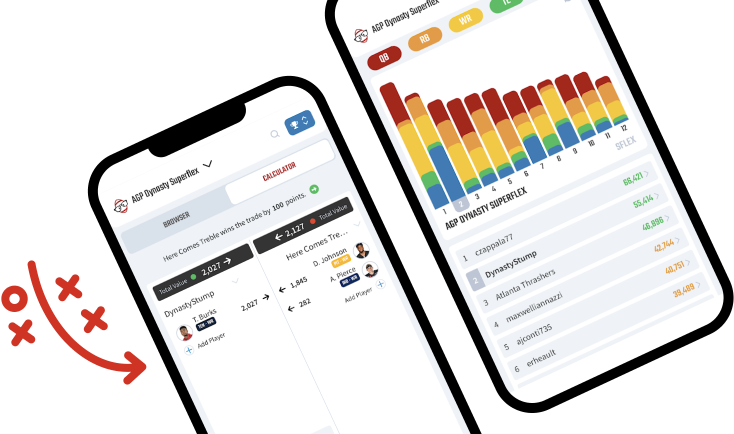Welcome back to the fifth season of the Fantasy Z-Score! A statistical blend of what metrics matter most in predicting future fantasy production.
I hope this model can provide you with actionable insight into each prospect’s profile, their pros and cons, and why it matters. The singular beauty of the Z-Score is in its transparency in the process, categorical grades, and final overall projection of PPG to satisfy those who are thirsting for a quick summary of the analysis, deep explanatory insight, and everything in between. Please scroll down to the “Method Behind the Madness” section for detailed explanations of the process and categories used.
Running backs were first; let’s look at wide receivers now.
2023 Dynasty WR Rankings and Predictions
This class is very weak in depth but has some excellent top-end talent and sleeper candidates compared to recent years.
Below you will find each player’s Fantasy Z-Score rating, a snapshot of their profile grades, and their current consensus ADP. A complete summary of the 2023 class all in one chart is included here for your viewing pleasure:

Tier 1
1. Quentin Johnston (LAC)
Projected PPG: 14.4
Consensus Rookie ADP: WR3

In what will likely be against consensus ADP, Johnston comes in as the WR Z-Score favorite. He ranks above average or great in every single available category with prototypical size (33-⅝” arms!), the third-best aggregate film grade in the class (although I hear he makes occasional body catches which are apparently the WORST – I’m being sarcastic for those new to me). Johnston had an age 18 breakout and is an early declare, second-best in YPTMA adj for team strength, and fourth-best in YPRR. His closest analytic comps are CeeDee Lamb, Justin Jefferson, Brandon Aiyuk, and Jerry Jeudy from a profile perspective, with hardly any red flags in his profile.
Being paired with Justin Herbert is about as attractive a spot as we can ask for. They project to be fairly pass-heavy for the foreseeable future, with new offensive coordinator Kellen Moore in town as well. We can feel comfortable drafting QJ as an expected back-end WR1/high-end WR2 for years.
2. Jaxon Smith-Njigba (SEA)
Projected PPG: 14.2
Consensus Rookie ADP: WR1
The Ohio State prospect darling has a plethora of reasons to have you excited about his elite production. The 4.4 YPRR, his sophomore season at his level of competition, is simply outstanding. It’s one of the best in my database, and he comes in with the highest overall career grade in the class. While I no longer profile in athleticism for WRs due to a low correlation and fewer players fully participating at the combine, JSN had a three-cone time of 6.57, which is historically elite. This matches up with his prowess as the best route runner in class.
Where Smith-Njigba misses out on an even better profile for me is his physical metric (namely smaller hands and short arms) and his good, albeit not top-tier, film grades. He often comes in as the second, third, or fourth-graded WR from the film sources I’ve found reliable over the years. Perhaps this is due to his lacking size and short-lived final season, but it is enough to bump him to WR2 in the class. Their scores are so similar that you can interchange them, pending personal preference.
Now the landing spot in Seattle is very interesting. If JSN underperforms in year one, he will become a major buy candidate. Similar to Treylon Burks being suppressed due to extremely low pass volume (among other factors). Despite all these factors, Smith-Njigba is a tremendous prospect firmly planted in tier one of this class.
Tier 2
3. Jordan Addison (MIN)
Projected PPG: 11.9
Consensus Rookie ADP: WR2

Our first steep tier drop in the rankings gives Addison. The undersized standout from USC had an excellent career, and most film grades all have him top three in the class. The rest of his profile is fairly middling, with good, not great, scores across the board. His final season efficiency was extremely average. A profile like this screams I like to play it safe rather than shoot for the upside in my personal experience.
Landing in Minnesota is an attractive location due to its immediate volume. However, I have him firmly behind Justin Jefferson and TJ Hockenson for the duration of their careers. I’m much more attracted to Addison in redraft leagues for these first few years than I am in dynasty.
Tier 3
4. Jalin Hyatt (NYG)
Projected PPG: 9.5
Consensus Rookie ADP: WR9

An electrifying playmaker, Hyatt has the second-best final-season efficiency in the class. The few film breakdowns I’ve seen of him almost always involve him running a straight line past defenders on his way to a big touchdown, where he puts his 4.40 speed on display. And if there’s one thing we know about the NFL’s evaluation of WRs, it’s that they love their speed. His late breakout and very subpar dominator ratings feel like it verifies him as a field stretcher and not much more. However, if I’m taking a gamble, I like to gamble on a guy who can win you your fantasy matchup with a single play.
Hyatt fell much further in the draft than expected, and the Giants receiving room is a scorching mess with everyone they brought in this offseason. He’s a fine stash in the late second of your rookie drafts, and a wide range of outcomes will be in play.
5. Josh Downs (IND)
Projected PPG: 9.0
Consensus Rookie ADP: WR7

How could two players ranked next to each other feel so opposite? Whereas Hyatt was an electric boom-or-bust playmaker, Downs is our unexciting Mr. Reliable. His low-end efficiency – a deplorable 2.3 YPRR – gets made up for by an outstandingly consistent and attractive career grade, led by his class-leading adjusted YPTMA at 11.48. He comps as a slot plus type with similar scores to guys like Elijah Moore, Tyler Lockett, and Tutu Atwell – a wide range of outcomes. I like his profile a bit more than these comps, as do the film gurus, so I tend to leave him on the plus side of that scale.
Downs was another WR who slid much further than expected in the draft. And being paired with the Colts – who just drafted a likely run-orientated QB in Anthony Richardson – is another disappointing addition to his profile. I like some features of his profile, so I’m alright with the gamble, but we have to dampen our expectations for his early career production severely.
6. Marvin Mims (DEN)
Projected PPG: 9.0
Consensus Rookie ADP: WR8

Mims was a devy favorite after bursting onto the scene his freshman year. Since then, his profile did little to nothing to add from that breakout season. This WR room is stupidly crowded, but the glimmer of hope is that we have an entirely new regime at the helm for the Broncos. This makes Mims as “their guy” versus having no real commitment to any of the others beyond contractual obligations. If we have learned anything from history, Sean Payton loves “his guys.” Everything else aside, Mims all around profiles as a good, not great, profile again.
7. Zay Flowers (BAL)
Projected PPG: 8.6
Consensus Rookie ADP: WR4

Flowers was profiled analytically as a late second-day or early third-day selection in the NFL draft, but the film grades come in much more favorably. It is the only thing saving him from sinking much lower in the ranks. Red flags are galore with a late declare, well below average efficiency, and poor career production even at a lower competition school in Boston College. Now the silver lining is sometimes players dragged down by a poor school program model adjusted have untapped upside that can get covered up.
Well, if that’s the case, he will need to tap into all of it because, as it stands, he is the most overrated WR in this class from a profile versus draft capital standpoint. I also don’t see how he carves out more of a target share over Mark Andrews, Rashod Bateman, and even Odell Beckham Jr. in the short term. Could he potentially be a buy-low after year one candidate?
8. Cedric Tillman (CLE)
Projected PPG: 8.5
Consensus Rookie ADP: WR11

I knew before last season was over that Tillman would be a Z-Score sleeper favorite. His per-game career production for his draft capital is the first of its kind. He drastically outperformed fellow teammate Hyatt in 2021 before only playing half a season in 2022, where Hyatt exploded onto the scene. Even still, he outperformed Hyatt in four of their six shared games last year! He is also a physical specimen at 6’3″, with 10″ hands and 32-¾” arms.
Now he blossomed exceptionally late in his career, including three straight early years of essentially “zero” production. In using per-game stats, I can’t help but be intrigued by the way he burst onto the scene and led his team when playing full-time. His draft stock should keep him under the radar, landing in Cleveland, making him an easy at-cost selection in the later rounds of your drafts.
Tier 4 continued – with Spark Notes
9. Nathaniel “Tank” Dell (HOU)
- Really impressive career production
- “Handpicked” by CJ Stroud to join during the draft
10. Jonathan Mingo (CAR)
- One of the rare X-style receivers in the class
- Really poor all-around profile (late declare, poor efficiency) propped by draft capital
- Good film grades
11. Rashee Rice (KC)
- Landing spot wet dream with Patrick Mahomes. That alone is worth a shot
- Like a slightly worse Mingo from a profile perspective
12. Jayden Reed (GB)
- Freshman breakout age
- Decent film grades
- Horrendous efficiency/production when adjusted for team strength
The remaining receivers can be found in the overall chart listed above. They are all a solid tier below these top-12, and their projections can give you an idea of what to expect.
Method Behind the Madness
Every year, I rerun the metrics in my database to ensure they are holding up consistently over time. This allows me to catch new trends in fresh data points, and/or to eliminate defective ways of thinking. Notably, I have found that Film Grades – from the right sources – provide a very effective balance to the Z-Score and, as such, are an added feature this year. Another is Yards Per Route Run in college, which will combine into final season grades with market share.
While some sections remain the same, the Z-Score constantly evolves to give a holistic picture of a prospect’s profile. I have weighted each category’s grade appropriately concerning its measured predictiveness of NFL success, but separating each grade allows for transparency and the freedom to weigh them as you see fit. Below you will find each category, followed by a short explanation of their use.
Draft Capital
- NFL draft pick placement.
Early Declare
- Wide receivers who declare early – less than four years of college – have an increased rate of NFL success to about four more points per game on average.
Team Adjusted Efficiency (Final Collegiate Season)
- Market Share of Receiving Yards Per Game of the final season, adjusted for team strength via SRS (Simple Rating System)
- YPRR (Yards Per Route Run) adjusted for team strength via SRS
Career Production
- Measure of Average Receiving Yards Per Team Pass Attempt (college career – per game)
- Dominator Rating per game of final two seasons, adjusted for SRS and SOS to get a full picture of the level of “dominance”
- This year, I also started adjusting this for team and opponent strength
Breakout Age
- The earlier they succeed in college, the earlier that success will typically translate to NFL
Physical Metric
- Hand Size
- Arm Length
- Height
- Weight
Film Grade (aggregated from three film sources)
- Correlated historical film grades from three sources, including DynastyNerds Nerd Score, into expected fantasy points per game.
Expected Team Passing Volume – Year 1
- Projected pass attempts per game as calculated through my Thru32 Team Projections
- Does NOT affect their exp ppg in years 2-4
- Just an indicator of their short-term value trend
Each final letter grade is representative of what echelon of PPG that player falls into. (E.g. an age 18 breakout age grades as an A). Please follow the resources mentioned below if you want a more detailed explanation of these categories.
NOTE: Many of these sections have not changed from the previous year’s articles, as their effectiveness remains unchanged and strong. Notable sections that have changed are Career Production, Film Grade balance, and Exp Team Pass Volume
Category Breakdown
Breaking down each category, we can understand their usefulness. As with any position, draft capital is self-explanatory. The higher the selection, the better the player likely is and the more investment from the team to ensure they succeed.
Early declare shows that the level of interest is strong for players considering omitting a final year of college to enter the NFL draft early. It’s also a testament to a player’s talent, as better players are sought after more fervently by scouting departments. This was a metric @LordReebs broke down in further detail here:
Taking a look at early vs non-early declare WRs for future fantasy success.
— Rich Hribar (@LordReebs) March 23, 2020
Should you be at all concerned on the surge Denzel Mims has made? Caution on draft favorites in Pittman, Edwards, Claypool, Johnson?
Let's explore the history…https://t.co/HygVN5kVeT
Career production is the most meaningful category in the Z-Score, next to draft capital. Average Yards Per Team Pass Attempt had the strongest single stat correlation to fantasy points in my database, essentially tying draft position. These were collected from the database Peter Howard found. I have also found that the dominator rating per game of the final two seasons shows more meaning than the traditional dominator (final season and best season). Still, oftentimes, these naturally happen to be the same. I then adjusted for internal team strength (SRS) and opponent strength (SOS), which can be found at sports-reference.com.
Team adjusted efficiency consists of blending two final season metrics, and is good for identifying the players you did the most when on the field in their last showings before the big show. Team adjusted market share highlights players who dominated on their team, and how good that production was relative to the overall team strength. Obtaining a 40% market share on LSU is far more difficult than a 40% market share on Liberty, and should be rewarded as such. This metric was inspired by Underdog analyst Hayden Winks and compiled once again through the database of sports-reference.com.
The second part is Yards Per Route Run, the metric that has risen in popularity over the past five years. Luckily for us, the SIS data hub has been tracking this for college athletes as well. Once again, when adjusted for team strength, pops as a strong metric in predicting their NFL careers; albeit it has a smaller historical sample size than nearly all other metrics in this list.
Next up is breakout age. While breakout age is somewhat baked into early declares and early college production, it gives another perspective because some players enter college older/younger than others. It also tells us the exact year they excelled, which may get lost in career arcs with hyper-efficient final seasons.
Film grades are one of the new additions this year. Film analysts from NFL.com, DynastyNerds, and others have shown that their work is becoming as reliable as draft capital as the years go by. The film grade in the Z-Score is a unique weighted blend of these grades so as not to become pigeonholed into one single group’s way of seeing a player’s potential on film. Sure enough, the combination of all three has shown stronger predictive power than any one by itself. This adds confidence to the metric, knowing it is only included the best, by balancing each other out when needed, and amplifying it when all align to see the same result.
Last and, yes, the least, are physical measurements. Physical measurements alone surprisingly carry more weight than combine athleticism for wide receivers, but all in all, neither is that important. People of any shape and size can succeed. Hand size, height, weight, and arm length are the measures used, and the final grade is more of a tiebreaker or red flag in the grades than a stand-alone use.
Expected passing volume once again does not affect a player’s expected PPG in the Z-Score. It is used solely to determine short-term trends as situations change quickly in the NFL. A “C” or lower could make a player a buy low after year one. Likewise, an “A” grade could make a player a sell after year one, depending on how they perform relative to expectations.
The Future of Z-Score
As years progress, I constantly am trying to keep up with the most meaningful trends and metrics as the game evolves. This has led to using a rolling window of no longer than ten years of prospects. In the past seven years, draft capital itself has a historical R-squared of 0.25 to three-year PPG, compared to an R-squared of 0.39 for the Z-Score.
Remember, these are three-year projections for PPG starting from year two, not solely rookie-year success. Playing the long game is crucial with respect to wide receivers and dynasty, considering their value remains much longer than the short-lived running back career arcs, for example. For year one rookie rankings, defer to my redraft rankings and projections when released with DynastyNerds and FantasyPros.
I hope this breakdown was helpful for you to find the stats that matter most when researching your rookie wide receivers for the upcoming season. Remember that projections are only a portion of what to consider when evaluating a prospect. Landing spots, coaching tendencies, and the supporting cast also play major roles. You can find full expectations and 2023 projections for all teams and players under my Twitter profile pinned link: “Freaks In The Spreadsheets” PDF fantasy guide for the full season.
Thanks for reading, and stay golden! If you like what you learned, follow me @DavidZach16 for more interesting stats and tidbits throughout the year.








